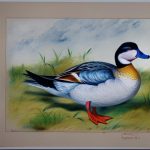Ducks are known for their quacking, but some breeds are particularly loud and vocal. These loud duck breeds can be a challenge for some owners, but they also bring a lot of personality and charm to a flock. In this article, we will explore the characteristics of loud duck breeds, compare their decibel levels, discuss the reasons for their loudness, and provide tips for managing and living with these vocal birds. Whether you are considering adding loud duck breeds to your flock or already have them and are looking for ways to manage their noise, this article will provide valuable insights and information.
Key Takeaways
- Loud duck breeds are known for their vocal nature and can be a challenge to manage.
- Characteristics of loud duck breeds include frequent quacking, honking, and other vocalizations.
- Comparison of decibel levels shows that loud duck breeds can be significantly noisier than other breeds.
- Reasons for loudness in ducks include breeding, environmental factors, and social interactions.
- Tips for managing loud duck breeds include providing adequate space, minimizing stress, and considering noise ordinances.
- Popular loud duck breeds include the Indian Runner, Khaki Campbell, and Welsh Harlequin.
- Living with loud duck breeds requires patience, understanding, and a willingness to accommodate their vocal nature.
Characteristics of Loud Duck Breeds
Loud duck breeds are known for their vocal nature and tendency to make a lot of noise. They are often more talkative and expressive than other duck breeds, and their quacking can be heard from a distance. These breeds are not necessarily aggressive or mean; they are simply more vocal and expressive in their communication. Loud duck breeds also tend to be more social and enjoy interacting with their human caretakers. They may follow you around the yard, quacking and chattering as they go about their day. Additionally, these breeds are often very active and energetic, enjoying swimming, foraging, and exploring their environment. They are not content to sit quietly in a corner but prefer to be out and about, making their presence known with their vocalizations.
On the physical side, loud duck breeds often have larger bills and more robust bodies, which may contribute to the volume and resonance of their quacks. Their vocal cords are also well-developed, allowing them to produce a wide range of sounds and calls. These breeds come in a variety of colors and patterns, from the classic white Pekin duck to the strikingly beautiful Mallard. Despite their loud nature, these ducks are often prized for their beauty and unique personalities, making them popular choices for backyard flocks and hobby farms.
Comparison of Decibel Levels
When it comes to comparing the decibel levels of different duck breeds, it’s important to note that individual ducks within a breed can vary in their vocalizations. However, certain breeds are consistently known for being louder than others. For example, the Indian Runner duck is one of the loudest duck breeds, with a quack that can reach up to 100 decibels. This breed is known for its upright posture and distinctive running motion, as well as its loud and frequent quacking. The Khaki Campbell duck is another loud breed, with a quack that can reach up to 90 decibels. This breed is prized for its excellent egg-laying abilities as well as its vocal nature.
On the other hand, some duck breeds are known for being quieter and less vocal. The Buff Orpington duck, for example, has a softer and more gentle quack that is not as loud as other breeds. The Swedish Blue duck is also known for being relatively quiet compared to some of the more vocal breeds. When choosing a duck breed for your flock, it’s important to consider the noise level that you are comfortable with and able to manage. While loud duck breeds can bring a lot of joy and entertainment to a flock, they may not be suitable for all environments or living situations.
Reasons for Loudness in Ducks
There are several reasons why some duck breeds are louder than others. One factor is genetics; certain breeds have been selectively bred for their vocalizations, resulting in ducks that are naturally more talkative and expressive. Additionally, environmental factors can play a role in a duck’s vocalizations. Ducks may become louder and more vocal when they are stressed, anxious, or seeking attention. For example, if they are hungry or thirsty, they may quack loudly to communicate their needs. Similarly, ducks may become more vocal during mating season or when they are establishing their social hierarchy within a flock.
Another reason for loudness in ducks is their natural instinct for communication and social interaction. Ducks are highly social animals that rely on vocalizations to communicate with each other and maintain group cohesion. In the wild, loud vocalizations can help ducks stay connected with their flockmates and alert each other to potential dangers or opportunities. This instinctual behavior carries over into domesticated duck breeds, leading to some breeds being naturally more vocal than others. Understanding the reasons behind a duck’s loudness can help owners better manage and accommodate their needs.
Tips for Managing Loud Duck Breeds
Living with loud duck breeds can be a rewarding experience, but it also requires some management strategies to ensure that both the ducks and their human caretakers are happy and comfortable. One tip for managing loud duck breeds is to provide them with plenty of space to roam and explore. Ducks that are cooped up in a small area may become more vocal as they express their frustration or boredom. Allowing them access to a large yard or pond can help them expend their energy and reduce their need to quack excessively.
Another tip is to provide enrichment activities that keep the ducks engaged and stimulated. This can include providing them with toys, puzzles, or foraging opportunities that encourage natural behaviors such as pecking, scratching, and exploring. Ducks that are mentally and physically stimulated are less likely to become bored or anxious, which can lead to excessive vocalizations.
Additionally, it’s important to address any underlying reasons for a duck’s loudness, such as hunger, thirst, or stress. Ensuring that ducks have access to fresh water, nutritious food, and a safe living environment can help reduce their need to quack excessively. Finally, providing positive reinforcement for quiet behavior can help train ducks to be less vocal. Rewarding them with treats or attention when they are calm and quiet can encourage them to be more mindful of their vocalizations.
Popular Loud Duck Breeds

Some of the most popular loud duck breeds include the Indian Runner, Khaki Campbell, Magpie, and Welsh Harlequin ducks. The Indian Runner duck is known for its upright posture and distinctive running motion, as well as its loud and frequent quacking. This breed is prized for its egg-laying abilities as well as its entertaining personality. The Khaki Campbell duck is another popular choice for backyard flocks due to its excellent egg production and vocal nature.
The Magpie duck is known for its striking black-and-white plumage as well as its loud quacking. This breed is highly social and enjoys interacting with its human caretakers. The Welsh Harlequin duck is prized for its beautiful silver coloration and friendly disposition, as well as its talkative nature. These breeds are popular choices for hobby farmers and backyard enthusiasts who enjoy the entertainment and charm that loud duck breeds bring to a flock.
Living with Loud Duck Breeds
In conclusion, living with loud duck breeds can be a unique and rewarding experience that brings joy and entertainment to a flock. Understanding the characteristics of loud duck breeds, comparing their decibel levels, exploring the reasons for their loudness, and implementing management strategies can help owners successfully care for these vocal birds. Whether you are drawn to the Indian Runner’s distinctive running motion or the Khaki Campbell’s excellent egg-laying abilities, there are many reasons to consider adding loud duck breeds to your flock. With proper care and management, these ducks can thrive in a variety of living environments while bringing their unique personalities and charm to those around them.
If you’re interested in learning more about poultry, you might also want to check out an article on Poultry Wizard about the best kind of coop for chickens. Understanding the different types of coops available can help ensure that your chickens have a comfortable and safe living environment. You can read the full article here.
FAQs
What are the loudest duck breeds?
Some of the loudest duck breeds include the Indian Runner, the Call duck, and the Rouen duck. These breeds are known for their vocal nature and can be quite noisy compared to other duck breeds.
Why are some duck breeds louder than others?
The loudness of a duck breed can be influenced by genetics, environmental factors, and individual personality. Some breeds may have been selectively bred for their vocal abilities, while others may be more prone to vocalizing due to their surroundings or temperament.
Are all ducks noisy?
Not all duck breeds are noisy. While some breeds are known for their loud quacking, others are relatively quiet. It ultimately depends on the individual duck and its breed.
How can I reduce the noise level of my ducks?
To reduce the noise level of your ducks, you can provide them with a calm and stress-free environment, ensure they have enough space to roam and forage, and consider the breed’s natural tendencies when choosing ducks for your flock.
Can loud ducks be kept in urban areas?
Loud duck breeds may not be suitable for urban areas due to noise regulations and the potential disturbance to neighbors. It’s important to consider the noise level of your ducks before keeping them in an urban setting.
Meet Walter, the feathered-friend fanatic of Florida! Nestled in the sunshine state, Walter struts through life with his feathered companions, clucking his way to happiness. With a coop that’s fancier than a five-star hotel, he’s the Don Juan of the chicken world. When he’s not teaching his hens to do the cha-cha, you’ll find him in a heated debate with his prized rooster, Sir Clucks-a-Lot. Walter’s poultry passion is no yolk; he’s the sunny-side-up guy you never knew you needed in your flock of friends!







